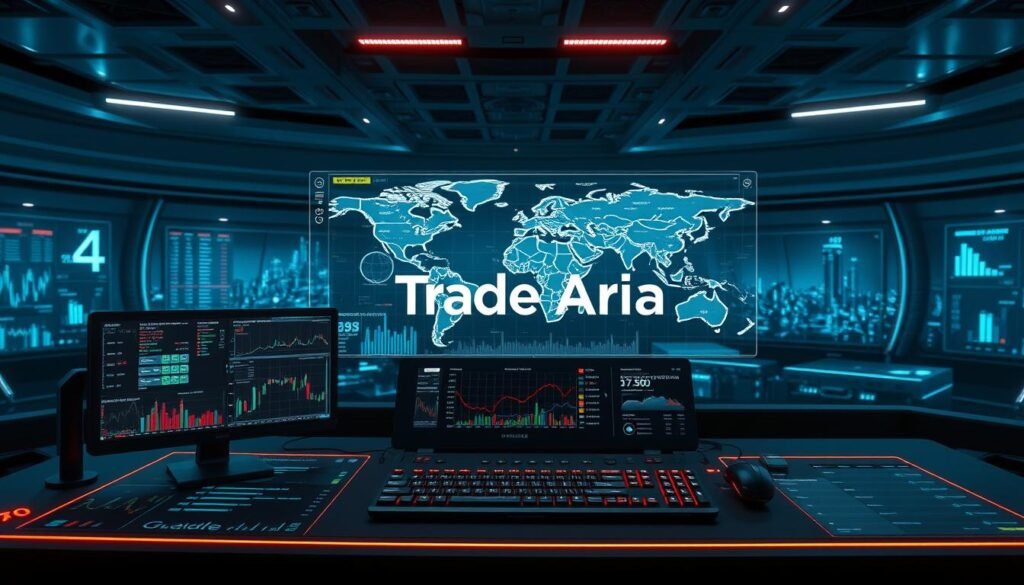Markets are getting ready for a big crypto bull run in 2025. Bitcoin’s dominance is key, and altcoins are getting more attention. Big players like MicroStrategy are changing how we think about investing.
Prices can change quickly: Token Metrics saw Bitcoin’s price drop from $124,000 to under $115,000 fast. This shows why choosing to hold or trade is so important for U.S. investors. Having a solid plan helps avoid making emotional decisions.
This article talks about the pros and cons of holding and trading. It also looks at how wealth managers and portfolio companies can plan investments. We discuss the role of presales, like MAGACOIN FINANCE, and the importance of safety and rules.
Key Takeaways
- Bull Run Strategies rely on market structure: Bitcoin dominance, big investors, and how coins move.
- Deciding to hold or trade depends on how long you want to invest and how much risk you can take. Both need a clear plan.
- An investment advisor can pick core investments, while a financial consultant might suggest active trades.
- Presales like MAGACOIN FINANCE are risky, early chances that should be taken with caution.
- Start planning early; waiting for popular news can mean missing out on early gains.
Bull Run Strategies: overview and what’s new for 2025
Markets are moving into 2025 with a fresh start. Asset classes are going through different phases. Traders and investors need to adjust their strategies to these changes.
Looking into 2025, we see stronger rallies driven by stories. Ethereum has been doing better than Bitcoin, making the ETH/BTC ratio hit new highs. This change makes portfolio managers think differently about when and how much to invest.
Bitcoin’s dominance is key for when altcoins start to move. So, keep an eye on Bitcoin for signs of change.
2025 might be unique because of big companies and clearer rules. Companies like MicroStrategy are buying more Bitcoin. The U.S. is also setting clearer rules. These changes affect how markets work, including how liquid and volatile they are.
Watch the battle between Bitcoin and Ethereum, and how altcoins move. Ethereum’s strength can push money into DeFi and L2. When Bitcoin’s dominance falls, money often goes to other tokens, creating chances for quick trades.
Financial advisors need to consider these trends when helping clients. For those who want to play it safe, sticking to well-known assets might be best. But for those looking for quick gains, timing trades based on Bitcoin and Ethereum can be profitable.
Presales and stories of scarcity are also big in 2025. Projects that sell out fast show how eager investors are. This, along with big investors and clear rules, makes for a complex market.
Why holding (HODLing) remains a core approach in bull markets
Past cycles teach clear lessons for investors who choose to HODL. In 2017, Ethereum surged more than 1,000% after Bitcoin liquidity thinned, rewarding patient holders. In 2021, meme tokens such as Dogecoin and Shiba Inu delivered outsized returns as narratives captured retail attention. Those episodes show that early positioning before broad market focus can matter a great deal.
Long-term compounding benefits are easiest to see when volatility is tolerated. Buy-and-hold reduces the need for precise timing and lets multi-year growth and network adoption drive gains. This approach suits investors who prefer steadier decision-making and lower stress compared with constant trading.
Presales can sit inside a holding plan as a satellite allocation. Projects that run limited presales often offer lower entry valuations and supply scarcity, which may translate to high upside for long-term holders. Analysts have cited projected returns for some early-stage offerings that make small, disciplined presale bets attractive within a broader portfolio.
Retirement planning experts and financial planning consultancy teams typically recommend a core-satellite framework. Core allocations favor established assets like Bitcoin and Ethereum while small satellite buckets include selective presales. Firms set strict allocation caps, custody arrangements, and vesting expectations to manage concentration risk.
Practical guidance for HODLers centers on rules and guardrails. Use dollar-cost averaging to lower entry timing risk. Keep presale stakes modest and perform due diligence on team experience, tokenomics, and community strength. Work with a retirement planning expert or financial planning consultancy to map vesting schedules and tax implications into a long-term plan.
Why active trading can outperform in a bull run
Active trading often beats passive holds when markets move fast. Traders who spot shifts between Bitcoin, Ethereum, and altcoins can make gains. A focused approach helps capture brief spikes and longer swings without missing the broader uptrend.
Capturing short- and medium-term rotations between Bitcoin, ETH and altcoins
Rotation trades happen when capital moves from BTC into ETH or specific altcoins. Watching the ETH/BTC ratio gives early clues for these flows. Traders can enter on breakout confirmations and exit as momentum fades. Swing trading lets a trader ride a sector move for several days to weeks while keeping risk tight.
Trading tools and indicators that perform well during bull cycles
Simple trader indicators like RSI and MACD work well when price trends are strong. RSI helps time pullbacks for lower-risk entries. MACD confirms momentum shifts and can catch trend changes ahead of price peaks. Moving averages act as dynamic support and filter for trend-follow setups. Combining these tools improves signal quality.
Examples of tradable themes in 2025: Chainlink, Base tokens, Pendle, Solana dip plays
Chainlink recently cleared a major resistance band near $22–23, creating a tradable breakout theme tied to oracle demand. Base ecosystem tokens may gain from Coinbase-driven DEX activity that boosts volume and volatility. Pendle shows high TVL relative to market cap, suggesting mispricing that active traders can exploit. Solana can offer dip plays when a 30–40% correction appears, letting swing traders target mean reversion entries.
| Theme | Why tradable | Primary indicators | Timeframe |
|---|---|---|---|
| Chainlink | Breakout above long-term resistance, enterprise demand for oracles | RSI for pullbacks, MACD for momentum, 50/200 MA for trend | Days to weeks |
| Base tokens (Aerodrome, Zora) | Volume catalysts from Coinbase, new DEX liquidity | Volume spikes, MACD cross, short-term moving averages | Days to weeks |
| Pendle | High TVL vs market cap implies mispricing opportunities | RSI for oversold entries, MACD divergence, 21 MA for re-entry | Weeks |
| Solana dip plays | Deeper corrections create clear swing entry points | RSI oversold zones, support levels, MACD recovery signal | Days to weeks |
Practical implication for traders and firms
Active trading can outperform when order management and stop-loss discipline are in place. Institutional flows and on-chain alerts help confirm setups. A portfolio management company often builds proprietary momentum screens and trader-grade scoring to raise hit rates. Executing with clear risk rules lets active traders convert rotation and momentum edges into consistent returns.
Assessing risk: investment risk assessment for holders and traders
Risk management begins with a detailed investment risk assessment. It separates long-term investments from risky bets. Companies like Vanguard and Fidelity use client profiles to limit exposure to small caps and presales.
A financial consulting firm should consider client time horizons, tax status, and liquidity needs before approving risky investments.
Position sizing must be clear and consistent. Traders should risk no more than 1–2% of their total capital per trade. They should also limit individual trade size to about 8–12% of their active trading capital.
Wealth management solutions should set hard caps on presale and small-cap exposure. For example, 3–7% of a diversified crypto sleeve within a broader portfolio is common.
Stop-loss placement and drawdown tolerance vary by role. Traders use stop orders and defined risk per position to protect capital. Long-term holders use rebalancing rules and stop-loss-free tranches to manage risks.
It’s important to have contingency plans for larger drawdowns. Wealth management solutions often define tiered actions. These include rebalancing at 10% deviation, trimming at 25%, and invoking client review at 40%.
A financial planning consultancy will tie these triggers to client liquidity events, retirement dates, and margin constraints.
Regulatory risks and macro triggers change quickly. Monitor Federal Reserve commentary, speeches at Jackson Hole, and FOMC minutes for liquidity shifts. U.S. policy changes around stablecoins, staking, or taxation can alter market structure overnight.
Institutional treasury accumulation by companies like MicroStrategy and public fund activity reduce float and can amplify moves. Track exchange flows, custody inflows at Coinbase and Binance US, and staking changes on Ethereum to gauge supply shifts’ impact on volatility.
| Risk Area | Retail Trader Guideline | Wealth Management / Financial Consulting Firm Guideline |
|---|---|---|
| Position sizing | 1–2% risk per trade, 8–12% max allocation per active position | Maximum 3–7% presale/small-cap per client crypto sleeve; scalable by risk profile |
| Drawdown control | Use stop-losses and trailing stops; avoid excessive leverage on spot positions | Tiered rebalancing: rebalance at 10%, review at 25%, client action at 40% |
| Execution | Prefer limit orders, account for exchange fees ~0.1%, watch slippage | Use institutional venues, custody solutions, and trade aggregation to reduce market impact |
| Regulatory monitoring | Follow Fed commentary and major policy shifts for liquidity cues | Keep compliance-ready playbooks for U.S. policy changes, stablecoin and staking rules |
| Contingency planning | Predefine emergency exit percentages and capital preservation rules | Client-level contingency plans tied to retirement timelines and liquidity needs |
Portfolio construction: blending holding and trading
Creating a strong crypto portfolio needs clear rules and the ability to adjust. Mix long-term holds with active trades to gain without losing everything. This method works for both small and big financial planning services.
Use core-satellite allocations to keep your long-term strategy safe while making quick moves. The core holds top assets like Bitcoin and Ethereum for steady growth. Satellites focus on mid-caps and new tokens for quicker gains.
Core-satellite model
The core-satellite model separates solid bets from quick trades. The core should be stable and tax-smart. Satellites have tighter controls, smaller sizes, and clear exit plans.
How a financial planning consultancy or portfolio management company might allocate
A cautious financial advisor might use 50–70% for the core, diversifying within it. Satellites could be 10–20% for mid-caps and themes. Presales would be 1–5% with strict rules.
| Bucket | Typical Range | Role | Risk Controls |
|---|---|---|---|
| Core (BTC, ETH, stable diversification) | 50–70% | Long-term capital appreciation and inflation hedge | Periodic reviews, custody with institutional providers |
| Satellites (mid-caps, thematic tokens) | 10–20% | Capture market rotations and sector rallies | Position limits, stop-losses, sizing caps |
| Opportunistic presales | 1–5% | High-reward early-stage exposure | Due diligence, lock-up rules, vesting schedules |
| Cash / Stablecoins | 5–15% | Liquidity for drawdowns and trade opportunities | Replenish limits, custody and yield options |
Rebalancing cadence and triggers
Choose a rebalancing schedule that fits your clients. Quarterly rebalancing is simple. Signal-based rebalancing can improve results for those who like to act fast.
Use clear signals for rebalancing, like when the ETH/BTC ratio changes. These signals can help trim or redeploy funds.
Wealth management teams should write down rebalancing rules in client policies. Clear rules on taxes, custody, and sticking to the plan help avoid emotional mistakes.
Presales and early-stage allocations: high reward, high risk
Presales and early-stage allocations can lead to big gains for those willing to take big risks. Buying before a public listing can secure lower prices and access rare tokens. But, if a project fails, the losses can be huge.
Success in presales often comes down to timing and how rare the tokens are. Tokens sold privately can see huge gains when they hit the market. But, these gains rely on the project’s success, its usefulness, and keeping the community engaged.
Investors should view early-stage allocations as high-risk bets. It’s wise to keep investments small and avoid using too much leverage. A cautious approach is to limit exposure and have a clear plan for when to exit.
Before investing, do your homework. Check the founders’ past successes and the project’s tokenomics. Look at the supply, planned caps, and vesting schedules. Also, check if the project has a clear roadmap and if the community is active.
The checklist below summarizes key due diligence points for presales and early allocations.
| Due diligence item | What to verify | Why it matters |
|---|---|---|
| Team background | LinkedIn, past projects, verifiable contributions | Execution likelihood and accountability |
| Token supply & scarcity | Total cap, burn mechanics, allocation rounds | Price support and upside |
| Vesting & tokenomics | On-chain schedules, cliff periods, unlock cadence | Mitigates dump risk after listing |
| Utility & roadmap | Live product, MVP milestones, developer commits | Drives adoption and sustained value |
| Community strength | Engagement rates, quality of discourse, partnerships | Signals demand and marketing reach |
| Legal & compliance | Disclosure, token sale terms, jurisdiction | Reduces regulatory tail risk |
MAGACOIN FINANCE is a good example in the presale space. It’s known for its tight supply and quick sell-out. Analysts see high upside due to its scarcity and demand.
Projected returns for MAGACOIN FINANCE are very high in optimistic scenarios. These estimates rely on the project’s narrative strength and buyer interest. But, there’s a risk that initial momentum could fade.
Practical steps include setting strict allocation limits, planning for custody, and regular reviews. A wise financial consulting firm will limit exposure, document the reasoning, and align bets with risk tolerance. Due diligence is key to finding real opportunities amidst speculation.
Technical strategies for traders during a bull run
Traders need clear, easy-to-follow plans for a bull market. This section shares practical technical strategies. They fit common exchange trade management tools and spot trading on Binance or Coinbase. Use these setups for entries, exits, and position sizing, keeping liquidity and fees in mind.
Trend-follow setups and moving-average rules
Trend-follow systems use moving averages and trendlines for multi-week moves. Look for a short-term MA crossing above a long-term MA as a primary entry signal. Confirm with rising volume and a clear slope on the longer MA.
Use layered entries: a first portion at the crossover, another on a minor pullback to the moving averages, and a final add if price holds above the trendline. Favor spot positions over high leverage to avoid liquidation risk during volatile pullbacks.
Swing entries using RSI and MACD confirmations
Swing trades work well in an overall bull trend. Use RSI to spot overbought or oversold extremes for timing. Pair RSI signals with MACD direction to confirm momentum.
Example tactic: enter when RSI drops near 40 during an uptrend and MACD histogram turns positive. Limit allocation per trade to a fixed share of trade capital, such as 8–12%, and place stop-losses to protect capital.
Support, resistance and exchange trade management
Define support and resistance from recent highs, pivot points, and volume nodes. Use limit orders to reduce slippage and stop-limit or OCO orders to automate exits on exchanges.
Account for liquidity and fees—typical maker/taker fees near 0.1% on major venues. Prefer order types that minimize market impact. For risk control, set stop-loss levels based on nearby support and use position-sizing rules to cap drawdowns.
| Setup | Entry Signal | Confirmation | Execution Tips |
|---|---|---|---|
| Trend-follow | Short MA crosses above long MA | Rising volume, slope on long MA | Layer entries, use limit orders |
| Swing trade | RSI near 40–45 in uptrend | MACD histogram turns positive | Limit orders, 8–12% position size |
| Support/resistance | Rejection at key level or bounce | Volume profile and recent pivots | Stop-limit, OCO, monitor slippage |
Practical rules for consistent execution
Keep a written trade plan with risk-reward targets and exact order types. Prefer spot trading if you lack strict risk controls. Use exchange features like limit, stop-limit and OCO to enforce your plan and reduce emotional exits.
Review trades after each session and log outcomes. Tight exchange trade management plus disciplined position sizing will preserve capital and let technical strategies compound gains over multiple bull cycles.
Passive strategies for holders and conservative investors
Conservative investors look for steady growth and less stress in volatile markets. They prefer passive strategies that don’t require constant decision-making. This is good for those planning for retirement who want predictable results and less hassle.
Dollar-cost averaging and when it helps in a volatile bull market
Dollar-cost averaging, or DCA, helps by buying a fixed amount at regular times. This method is great in markets that swing a lot, as it lowers the cost over time. It’s a smart choice for those who don’t want to worry about timing the market.
DCA works well with regular payments into accounts. Experts suggest setting up monthly contributions. This helps keep investors on track and matches their income.
Buy-and-hold psychology and securing long-term gains
Buy-and-hold is effective for those who invest in big ideas and let them grow. It saves on trading costs and taxes, boosting returns. It’s important to set limits to avoid too much risk in one area.
To stick with buy-and-hold, it’s key to have rules against selling too soon. Investors should check their plans with advisors to stay on track.
Using secure wallets, custody options and asset management services for safety
Security is key for long-term investors. Small accounts can use hardware wallets like Ledger or Trezor. For bigger amounts, firms like Coinbase Custody or BitGo offer safe storage.
Asset management services add extra security with multi-signature custody and insurance. They also provide clear reports. This mix of safety and a solid investment plan protects wealth in a bull market.
| Investor Profile | Recommended Passive Strategy | Custody Suggestion | Why it fits |
|---|---|---|---|
| Retail saver | Monthly DCA into large-cap assets | Hardware wallet (Ledger/Trezor) | Low fees, simple automation, strong security |
| High-net-worth individual | Core buy-and-hold with allocation limits | Institutional custody (Coinbase Custody, BitGo) | Insurance coverage and compliance for large balances |
| Advisor managing client accounts | Core-satellite: regulated assets core, small speculative satellite | Asset management services with multi-sig and reporting | Fiduciary standards, transparent reporting, custody proof |
| Retirement-focused investor | Automated DCA inside IRAs and retirement accounts | Custodial accounts through broker-dealers or trust providers | Tax-advantaged structure, disciplined contributions |
When to favor trading: signals and momentum indicators
Active traders rely on clear signals and momentum indicators to find the best times to buy. They read price movements, watch for big swings, and consider on-chain data before making a move.
When Bitcoin’s price drops fast, like from $124k to under $115k, it often means it’s time to sell. Traders who see these drops as chances to buy stronger assets can do well. They use RSI and MACD with volume to spot when it’s time to buy back in.
Altcoin momentum changes can be seen through market breadth. If more than 60% of gains go to altcoins, it’s usually a sign of an altcoin season. This helps traders avoid chasing weak rallies by using breadth with momentum indicators.
The ETH/BTC ratio is key for deciding when to switch between assets. When this ratio goes up, it means Ethereum and related tokens are in favor. Traders can then reduce their BTC and increase their ETH holdings when the ratio and momentum indicators are positive.
Institutional flows and corporate treasury buys add a layer of structure. When big players like MicroStrategy buy, it reduces the available supply and lowers risk. Traders can take bigger positions or tighten their stops when these flows support the trend.
Combine trader-grade momentum screens, market breadth, and institutional flow trackers to find the best trades. A portfolio management company might use these inputs to rank trade ideas and decide how big to make positions.
When to favor holding: macro and narrative confirmations
In rising markets, certain signs can make holding onto investments a smart move. Look for times when policy, corporate actions, and ecosystem health all point in the same direction. This alignment helps reduce risks and makes it easier to keep investments steady through ups and downs.
Clear rules in the United States make it safer to invest for the long term. When the SEC and Treasury make their rules more predictable, advisors can suggest holding onto investments for longer. This clarity, combined with other positive signs, makes for a solid investment strategy.
When big companies start buying into digital assets, it’s a sign of their confidence. Companies like MicroStrategy buying Bitcoin or adding Ethereum to their balance sheets show they believe in the future. This confidence can make investors feel more secure about holding onto their investments.
Look for ecosystems that are growing and showing signs of lasting success. Platforms like Ethereum and Solana with active developers, growing value, and strong user interest are promising. These signs suggest that the projects are here to stay, making them good choices for long-term investments.
Presales with long vesting periods can be a good way to invest in new ideas. When these presales have clear goals and milestones, the risk of selling too soon is lower. This setup helps align the interests of founders and investors, making it easier to hold onto these investments.
Financial advisors should base their investment advice on big-picture signs. If the Fed is optimistic, rules are clear, and companies are buying into digital assets, it’s a good time to hold onto investments. Use these signs to suggest longer holding periods for your clients’ core investments.
Practical risk management and execution tactics
Execution is where plans meet markets. Traders and advisors should use clear rules for entries, exits, and record-keeping. This helps portfolios survive volatile moves and tax seasons. Below are focused tactics that blend trade execution with client-level controls favored by a financial consulting firm.
Order types, liquidity considerations and slippage for traders
Choose order types that limit surprise fills. Use limit and stop-limit orders for defined entry and exit prices. One-cancels-the-other (OCO) pairs work well to place profit targets and protective stops at the same time.
Trade on venues with proven depth. Exchanges such as Binance and Coinbase list instruments with larger order books that reduce price impact. Watch TVL for DeFi tokens to gauge on-chain liquidity before sizable swaps.
Plan for slippage by estimating expected impact per trade size. Implement small test fills, then scale. Spot trading avoids liquidation risk that accompanies margin, keeping slippage predictable and fees near 0.1% per trade on many major exchanges.
Position limits, diversification and contingency planning for clients
Set position limits that match each client’s documented risk tolerance and retirement goals. That keeps single-asset bets within a firm’s risk budget and supports diversified portfolios across caps and sectors.
Design contingency plans for stress events. Include crisis liquidity lines, counterparty checks, and predefined rebalancing triggers. Review counterparties and custodians periodically to reduce settlement and operational exposures.
Document mandates in client agreements. A financial consulting firm should maintain written diversification rules and escalation paths for emergency trading or forced deleveraging.
Tax-aware execution and record-keeping for U.S. investors
Adopt tax-aware execution that minimizes friction at reporting time. Track cost basis, timestamps, and transaction types for every trade, swap, and staking reward. That simplifies capital gains calculations and supports tax-loss harvesting when appropriate.
Choose custodians and platforms that provide complete transaction reports. Maintain backups of trade history and client statements so CPAs can reconcile taxable events accurately.
| Focus Area | Practical Tactic | Client Benefit |
|---|---|---|
| Order types | Use limit, stop-limit and OCO orders | Controls entry/exit, reduces unintended slippage |
| Liquidity | Trade on deep order books; monitor TVL | Lower price impact, faster fills for large orders |
| Slippage | Estimate impact, use test fills, scale sizes | Predictable execution costs, fewer surprise losses |
| Position limits | Enforce written caps per client mandate | Reduced concentration risk, aligned with goals |
| Diversification | Allocate across market caps and strategies | Smoother returns, lower portfolio volatility |
| Contingency planning | Predefined liquidity lines and counterparty checks | Faster response in market stress, preserved capital |
| Tax-aware execution | Track cost basis; use custodians with reports | Simpler tax filing, better after-tax returns |
Metrics and dashboards to monitor for decision-making
Start with a clear metrics dashboard that combines on-chain and off-chain data. Traders and advisers need simple panels. These should highlight BTC dominance, TVL, exchange flows, and momentum at a glance.
On-chain indicators like BTC dominance and the ETH/BTC ratio are key. They show how capital moves between Bitcoin and altcoins. TVL for DeFi projects and supply concentration in treasuries reveal real liquidity and risk.
Exchange flows give timely clues about selling pressure. Large inflows to Binance, Coinbase, or Kraken often precede market weakness. Outflows to self-custody or insured custody point to accumulation by long-term holders.
Momentum scores and trader grades help screen tradeable setups. Use RSI and MACD confirmation alongside moving-average trends. Trader grades should combine technical momentum with fundamentals like developer activity and token utility.
Beginner-friendly dashboards present DCA performance, trade P&L, and stop-loss tracking. This makes trade outcomes clearer for retail clients. It helps advisers explain short-term actions in plain language.
Wealth management solutions integrate these metrics into client reporting. Portfolio management companies blend custody statements, on-chain metrics, and rebalancing triggers into client-facing views. These views show allocations and risk.
For presale and token screening, add lockup and vesting schedules to the dashboard. Seeing TVL, market cap ratios, and token release timelines reduces surprises. It highlights projects with real scarcity.
Build a compact table that advisors can share with clients. Columns should include signal, indicator source, current reading, and suggested action. Clear rows for BTC dominance, TVL, exchange flows, and trader grades make decisions repeatable.
| Signal | Indicator | Current Reading | Suggested Action |
|---|---|---|---|
| Market leadership | BTC dominance | Rising vs. falling trend | Shift allocation toward Bitcoin or altcoins |
| DeFi health | TVL vs. market cap | High TVL relative to cap | Consider DeFi exposure for income strategies |
| Liquidity pressure | Exchange flows | Net inflows or outflows | Tighten stops or add scale-in orders |
| Trade priority | Trader grades | Momentum + fundamentals score | Prioritize high-grade setups for active trades |
Keep reporting short and visual. Wealth management solutions should let clients filter by risk band, time horizon, and strategy. This approach makes metrics actionable in meetings with financial planning consultants.
Regularly review the dashboard process. Calibrate trader grades with real P&L and update exchange flows thresholds. Small changes in inputs keep the system responsive as markets evolve.
Behavioral and psychological differences: trader mindset vs investor mindset
Understanding how people think during a bull market helps shape better choices. Behavioral finance shows why emotions often drive decisions that clash with plans. A clear briefing sets expectations and makes subsequent steps easier for both clients and advisors.
Common cognitive biases in bull runs and how to mitigate them
FOMO can push traders into risky entries near peaks. Anchoring to past highs leads investors to expect quick repeats. Recency bias makes recent gains feel permanent. The disposition effect tempts sellers to lock small gains while holding losers too long.
Mitigation starts with rules. A trading plan prevents emotional decisions. Pre-defined stop-losses, position-size limits and regular rebalancing reduce impulse trades. Using checklists for presales and speculative buys limits exposure. Beginner traders should avoid over-leveraging and stick to set limits.
Setting financial goals with your investment strategy advisor or portfolio management company
Start with time horizon and risk tolerance. An investment strategy advisor will translate goals into allocations, from cash and bonds to presales and altcoins. Define caps for speculative positions and vesting expectations for early-stage allocations.
Scenario planning clarifies outcomes for retirement, growth or liquidity needs. Regular reviews update allocations as goals change. This approach increases the chance of financial goal achievement by linking choices to measurable milestones.
Communication and expectation-setting for clients of retirement planning experts
Retirement planning experts should set realistic return ranges and allowed speculative exposure. Clear quarterly reports and simple dashboards keep clients grounded during rallies and corrections.
Education on market cycles and stress-test outcomes reduces panic behavior. Firm rules for allowable presale caps and documented rebalancing plans help advisors enforce discipline and improve long-term outcomes.
Conclusion
Being prepared is key for a strong 2025 bull run. Mix big names like Bitcoin and Ethereum with smart presales. This approach balances risks and opens up big opportunities.
The market can change quickly. Bitcoin’s strength and Ethereum’s growth can shift what’s possible. Big investors and clear rules will shape the future. Traders should mix short-term and long-term strategies. Holders should stick to long-term plans.
Both trading and holding are important for reaching financial goals. Use a mix of strategies and do your homework on new projects. Wealth management can help turn plans into action.
Remember to think about taxes, safety, and how data moves. Work with experts to fit your risk level and aim for long-term success.
FAQ
What’s the market context entering 2025 and why could this bull run differ from prior cycles?
Markets are getting ready for a 2025 bull run after early-year ups and downs. Public companies are adding BTC and large ETH treasuries. Clear U.S. regulatory signals and growing mainstream adoption are key differences.
Bitcoin dominance and ETH/BTC ratio moves are now more important. On-chain rotations play a bigger role than before.
Should U.S. investors mainly hold (HODL) or actively trade in 2025?
Both strategies have their place. HODL and DCA are good for long-term BTC/ETH and blue-chip tokens. They benefit from compounding and institutional support.
Active trading can grab short-to-medium term gains. But, it needs strict risk controls and monitoring of institutional flows.
How do presales like MAGACOIN FINANCE fit into a portfolio?
Presales are high-risk, high-reward satellite allocations. They offer lower valuations and upside but come with risks. Financial planning consultancies recommend small allocations to presales.
They suggest strict due diligence, long vesting horizons, and custody plans.
What proven strategies should beginners consider during a crypto bull run?
Beginners should use core strategies. Dollar-cost averaging and HODL for long-term compounding are good. Spot trading with no leverage is also an option.
Follow simple rules: set allocation caps, avoid emotional exits, and use secure custody for U.S. tax reporting.
Which trading tools and indicators work best in a bull market?
Effective indicators include moving-average crossovers and RSI/MACD for swing entries. Volume and trendline confirmation are also key. Track ETH/BTC ratio, market breadth, and institutional buying.
What position sizing and stop-loss rules do wealth management solutions recommend?
Wealth management firms suggest 50–70% of assets in BTC/ETH/stable diversification. Midcaps or thematic tokens should be 10–20%. Opportunistic presales are 1–5%.
For traders, limit exposure per trade to 10% of capital. Use stop-losses and avoid excessive leverage.
How should a financial planning consultancy allocate between core and satellite holdings?
A core-satellite model is typical. Allocate 50–70% to BTC, ETH, and liquid blue-chips for long-term goals. Mid-caps and thematic plays are 10–20%.
Opportunistic presales are 1–5% with strict vesting and custody rules. Rebalance based on BTC dominance and ETH/BTC thresholds.
What are the main risks with presales and how do I due diligence them?
Risks include team failure, poor tokenomics, and short vesting. Lack of utility and regulatory exposure are also risks. Due diligence checklist includes team background, tokenomics, vesting, roadmap, and legal terms.
Which tradable themes look promising in 2025?
ETH outperformance and ETH/BTC rotations are promising. Chainlink, Base ecosystem tokens, Pendle, and Solana dip plays are also good. Monitor liquidity and TVL before entering.
How do institutional treasury buys affect strategy choice?
Institutional accumulation reduces circulating supply and supports valuations. It justifies wider stop placements or longer hold periods. Such flows are contextual signals for sustained rallies.
What market indicators should investors monitor to time rotations?
Monitor BTC dominance, ETH/BTC ratio, market breadth, and exchange flows. On-chain treasury holdings and momentum scores are also important. Rising ETH/BTC and breadth favor altcoin rotation.
How should traders manage execution, fees, and slippage on exchanges?
Use limit and stop-limit orders, and prefer sufficient liquidity pairs. Spot trading avoids liquidation risk. Expect fees around ~0.1% on major exchanges.
What are prudent custody and safety practices for U.S. investors?
Use hardware wallets for personal holdings. Institutional custody providers and multi-signature setups are best for client assets. Insured custodial options are also available.
Keep detailed transaction records for tax reporting. Align custody choice with wealth management solutions that provide transparent reporting.
How do tax and record-keeping requirements affect trading and holding decisions?
U.S. investors must track cost basis, trades, swaps, and staking rewards. Frequent trading increases reporting complexity. Choose custodians and portfolio management services that generate clear transaction reports.
When should investors favor trading over holding based on momentum signals?
Favor trading when momentum indicators show clear trend strength or shifts. ETH/BTC rising to signal rotation into ETH is a good sign. Market breadth indicating altcoin season is also a signal.
Combine indicators with institutional flow data and liquidity checks before committing.
When is holding the better strategy?
Holding is preferred when macro and narrative confirmations align. Regulatory clarity, sustained institutional treasury accumulation, and strong ecosystem growth are signs. Presales with long lockups also support holding.
What practical risk management steps should financial consulting firms enforce for clients?
Enforce position limits, clear allocation mandates for speculative assets, and contingency plans for drawdowns. Counterparty risk mitigation and documented client risk tolerances are also important. Provide regular reporting, stress tests, and education to avoid behavioral biases.
Which dashboards and metrics should wealth management solutions integrate for clients?
Integrate BTC dominance, ETH/BTC ratio, TVL for DeFi projects, exchange flows, and momentum scores. Client dashboards should combine on-chain/off-chain data with custody reporting. Show allocations, performance, and risk metrics in one view.
How do cognitive biases affect decisions in a bull run and how can they be mitigated?
Common biases include FOMO, anchoring, recency bias, and the disposition effect. Mitigate them with pre-defined rules, stop-losses, regular rebalancing, and allocation caps. Advisor oversight and scenario planning also reduce panic behavior during corrections.
What final practical tips help balance holding and trading during a 2025 bull run?
Use a core-satellite portfolio: keep a durable core in BTC/ETH, allocate modest satellites to midcaps, and limit presales to a small opportunistic sleeve. Adopt strict risk controls, use appropriate custody, and monitor ETH/BTC and breadth for rotation signals.
Involve investment strategy advisors or portfolio management companies to align actions with financial goals and tax obligations.









